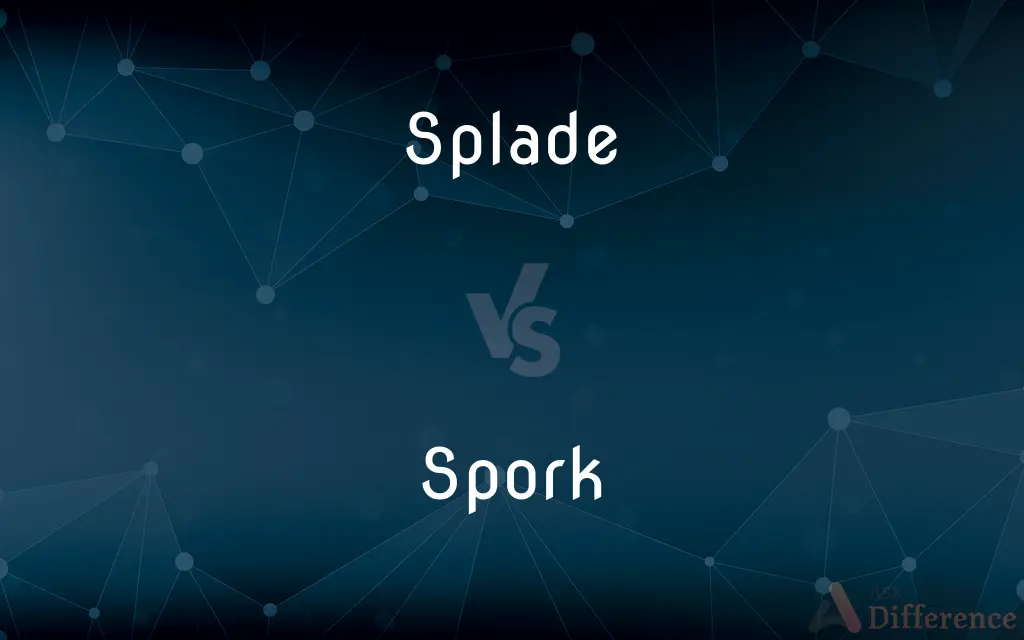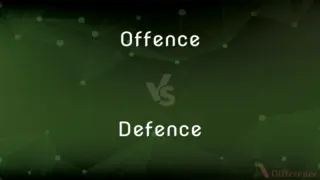Splade vs. Spork — What's the Difference?
By Tayyaba Rehman — Updated on September 22, 2023
A splade is a utensil combining features of a spoon and blade, while a spork is a hybrid of a spoon and fork.

Difference Between Splade and Spork
Table of Contents
ADVERTISEMENT
Key Differences
A splade, often considered a unique eating tool, is a utensil that amalgamates the attributes of a spoon with those of a blade or knife. This fusion enables the splade to be versatile, especially in tasks like spreading and cutting softer items. Conversely, the spork, a more commonly recognized hybrid utensil, merges the characteristics of a spoon and a fork.
Both splade and spork were designed to offer multiple functionalities with a singular tool, thereby reducing the need for multiple cutlery items. While the splade excels in both spreading tasks and cutting tasks that don't require a sharp edge, the spork is adept at scooping like a spoon while also being able to pierce food, courtesy of its tines, much like a fork.
The design intricacies between a splade and spork also denote their different purposes. A splade typically has a broader, flatter blade-like section which can efficiently spread butter or jam. In contrast, the spork often possesses a rounded spoon-like bowl combined with fork-like tines at the tip, making it suitable for a range of foods, from salads to soups.
Splades are less prevalent in everyday dining compared to sporks. The latter has gained significant popularity, especially in settings like camping or fast-food chains, where minimizing the number of utensils can be beneficial. While both splades and sporks represent innovative solutions to dining needs, their individual features dictate their best-suited applications.
Comparison Chart
Components
Combines spoon and blade
Combines spoon and fork
ADVERTISEMENT
Main Uses
Spreading and cutting softer items
Scooping and piercing food
Design
Broader, flatter blade-like section
Rounded bowl with tines at the tip
Common Settings
Less common in everyday dining
Camping, fast-food chains, and picnics
Origin
Less clear, but known to be used in some Australian homes
Originated from the merger of the words spoon and fork
Compare with Definitions
Splade
A lesser-known hybrid eating tool.
She was intrigued by the splade's design at the restaurant.
Spork
A utensil merging a spoon and fork.
He found the spork perfect for his salad.
Splade
A combination of spoon and blade characteristics.
The splade proved useful for both her soup and her soft bread.
Spork
Suitable for both scooping and piercing.
Using a spork, he ate both the soup and the chicken.
Splade
A utensil blending a spoon and blade.
She used a splade to spread the jam smoothly on her toast.
Spork
A common tool in camping and fast-food scenarios.
She always packed a spork for her hiking trips.
Splade
A multi-purpose cutlery item for spreading and cutting.
The splade's unique design made buttering the bread easy.
Spork
A hybrid cutlery design for versatility.
The spork's design made it a favorite in the cafeteria.
Splade
Typically broader and flatter than standard spoons.
She appreciated the splade's wide surface when serving the dip.
Spork
Derived from the words spoon and fork.
The name spork cleverly described its dual functionality.
Splade
A spork that is sharp along one edge or both edges, enabling it to be used as a knife, a fork and a spoon.
Spork
A spork is a hybrid form of cutlery taking the form of a spoon-like shallow scoop with two to four fork-like tines. Spork-like utensils, such as the terrapin fork or ice cream fork, have been manufactured since the late 19th century; patents for spork-like designs date back to at least 1874.
Spork
A spoon-shaped eating utensil with short tines at the tip.
Spork
An eating utensil having a spoonlike bowl and tines.
Spork
An eating utensil shaped like a spoon, the bowl of which is divided into tines like those of a fork, and so has the function of both implements; some sporks have a serrated edge so they can also function as a knife.
Spork
(transitive) To move or impale (food etc.) with a spork.
Spork
Trademark for a plastic eating utensil that has both tines and a bowl like a spoon
Common Curiosities
Where did the term "spork" come from?
The term "spork" is a fusion of the words "spoon" and "fork."
Is the splade a modern invention?
While its exact origins are less clear, splades have been used in some Australian homes for decades.
Can I use a splade to cut meat?
A splade can cut softer items but might struggle with tougher meats.
What is a splade primarily used for?
A splade is mainly used for spreading and cutting softer items.
What materials are sporks typically made of?
Sporks can be made of plastic, metal, or bamboo, among other materials.
Can I find splades in regular stores?
Splades are less common but might be found in specialty or kitchenware stores.
Are there different designs of sporks?
Yes, while the basic function remains, sporks can vary in design and the prominence of tines.
How do I clean a splade?
Like other cutlery, splades can be hand washed or placed in a dishwasher, depending on material.
Where can I buy a splade?
Specialty kitchenware stores or online platforms might offer splades.
Is the spork more popular than the splade?
Yes, the spork is more commonly recognized and used, especially in camping and fast-food settings.
What's the main design feature of a splade?
A splade typically has a broader, flatter blade-like section.
Is a spork practical for all types of foods?
Sporks are versatile, suitable for many foods, but might not replace specialized cutlery for all dishes.
Can I use a splade for cooking?
While primarily an eating tool, a splade might be useful in some cooking tasks like spreading or gentle cutting.
Are sporks environmentally friendly?
Reusable sporks, especially those made from sustainable materials, are eco-friendly compared to single-use plastic ones.
In what scenarios is a spork most beneficial?
A spork is ideal for travel, camping, picnics, and places where minimizing utensils is handy.
Share Your Discovery

Previous Comparison
Spaghetti vs. Linguine
Next Comparison
Offence vs. DefenceAuthor Spotlight
Written by
Tayyaba RehmanTayyaba Rehman is a distinguished writer, currently serving as a primary contributor to askdifference.com. As a researcher in semantics and etymology, Tayyaba's passion for the complexity of languages and their distinctions has found a perfect home on the platform. Tayyaba delves into the intricacies of language, distinguishing between commonly confused words and phrases, thereby providing clarity for readers worldwide.
















































